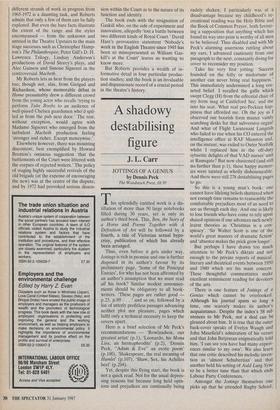Growing dissension at the Court
Joan Plowright
THE ROYAL COURT THEATRE by Philip Roberts
Routledge and Kegan Paul, £18.95
Thirty or more years ago serious stud- ents of the theatre were still burying their noses in books about the Moscow Arts Theatre; fascinated by reports of backstage rows and tingling with shock at the discov- ery that Chekhov's Seagull was booed off the stage on opening night. In 30 years time it is more than probable that the Royal Court Theatre will occupy a similar position in theatrical history; and the rev- elations of its attendant personalities and their battles against censorship, a hostile public, 'the flippancy of the critics' and each other will make fascinating reading.
But unlike the Moscow Arts, the Royal Court will never become a prestigious national monument, carefully preserving the traditions and style of its founder director. Even so, as Philip Roberts subtly demonstrates in these pages, the influence of George Devine was far reaching and the achievements of his reign made it a hard act to follow. Roberts's meticulously researched book is about those who followed and the new writers they championed, (including Christopher Hampton, David Storey, Howard Brenton, David Hare and Edward Bond) and contains some startlingly honest and revelatory comments from leading figures in contemporary English theatre.
We learn that Devine's successor, Will- iam Gaskill, was 'the chosen son of George' (like Devine, Gaskill is also a great teacher) and that he finally accepted the post, after an initial hesitation, because `the continuity of George's work was more important than working at the National Theatre'.
Mr Roberts provides ample proof of this fierce loyalty to the Royal Court and its ideals which survives in most people who have worked there; despite the frequent clash of personalities and even fund- amental disagreements over policy. As Devine believed that each period had got its own special kind of vitality those who followed were free to choose their own method of getting in touch with it.
Gaskill's triumphant fight to stage Ed- ward Bond's Saved (for which the theatre was prosecuted) gained the support of the entire profession; and was to become the high point in a lengthy battle waged and finally won by the theatre against cen- sorship. But, having got rid of the Lord Chamberlain (and with Bond established as a major playwright) Gaskill admits to having felt 'empty and directionless' and adds 'he had in a strange way given us a kind of raison d'etre'.
It was at this point, after four years work, that Gaskill was joined by Anthony Page and Lindsay Anderson to run the theatre as a triumvirate. With three such formidable and properly egotistical talents brushing off against each other sparks were expected to fly. Their separate achieve- ments, as well as their serious disagree- ments are well chronicled, as indeed is their first united stand against the critics.
It was Hilary Spurling (then of the Spectator) who first incurred the wrath of the directorate to the extent of being deprived of her free first night tickets. The press rose up in arms, Lord Goodman intervened, and the Royal Court's board was placed in an impossible position with the Arts Council who threatened to with- draw their grant. The unrepentant Lindsay Anderson chastised the press for its use of words like 'banned', 'barred' or 'excluded' and defended their rather shaky position with the statement: 'We are not preventing Mrs Spurling from either coming to this theatre or from writing about it. We are just not going to invite her to do so, and we would be hypocritical if we did.' The escalation of the row makes for good reading, but the fun to be got out of it is not allowed to obscure the validity of some of their complaints.
The book is only intermittently as enter- taining as that; to keep track of all the different strands of work in progress from 1965-1972 is a daunting task, and Roberts admits that only a few of them can be fully explored. But even the bare facts illustrate the extent of the range and the styles encompassed — from the unknown and untried in the Theatre Upstairs to the main stage successes such as Christopher Hamp- ton's The Philanthropist, Peter Gill's D. H. Lawrence Trilogy, Lindsay Anderson's productions of David Storey's plays, and Alec Guiness and Simone Signoret in the controversial Macbeth.
Mr Roberts lets us hear from the players too; though not, alas, from Gielgud and Richardson, whose memorable debut in Home presumably drew a different crowd from the young actor who recalls 'trying to perform Tube Boobs to an audience of well-pissed Chelsea guardsmen who'd spil- led in from the pub next door.' The rest, without exception, would agree with Madame Signoret who emerged from the turbulent Macbeth production feeling `stronger and richer. Except moneywise.'
Elsewhere however, there was mounting discontent; best exemplified by Howard Brenton's ominous suggestion 'that the battlements of the Court were littered with the corpses of rejected writers.' The policy of staging highly successful revivals of the old brigade (at the expense of encouraging the new) was at the centre of the dispute; and by 1972 had provoked serious dissen- sion within the Court as to the nature of its function and identity.
The book ends with the resignation of Gaskill who, on the side of experiment and innovation, allegedly 'lost a battle between two different kinds of Royal Court.' David Hare's provocative statement 'Nobody's work in the English Theatre since 1945 has been so misrepresented as William Gas- kill's at the Court' leaves us wanting to know more.
But Roberts provides a wealth of in- formative detail in four particular produc- tion studies; and the book is an invaluable and dispassionate record of a crucial period in the theatre's history.




































 Previous page
Previous page